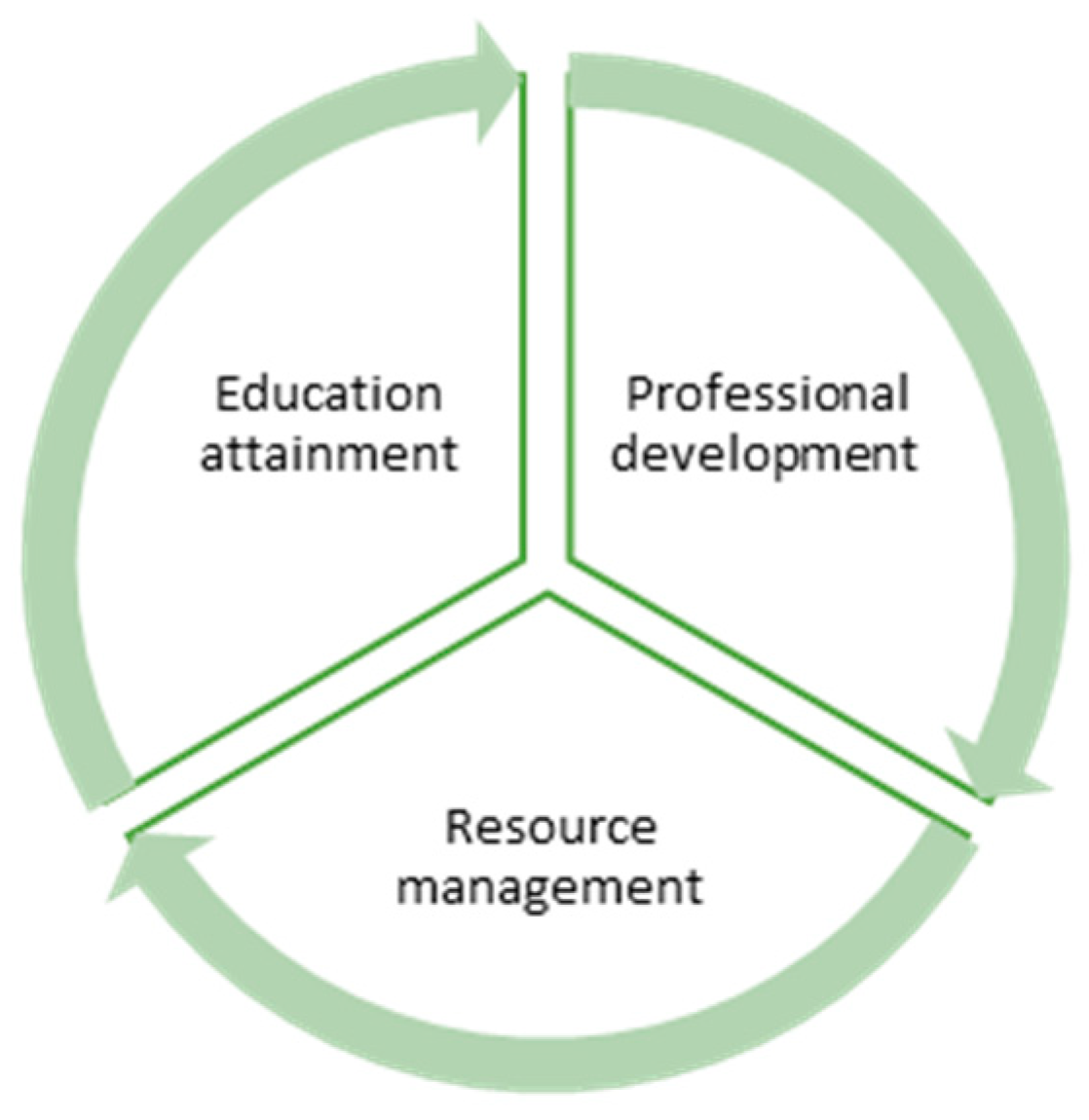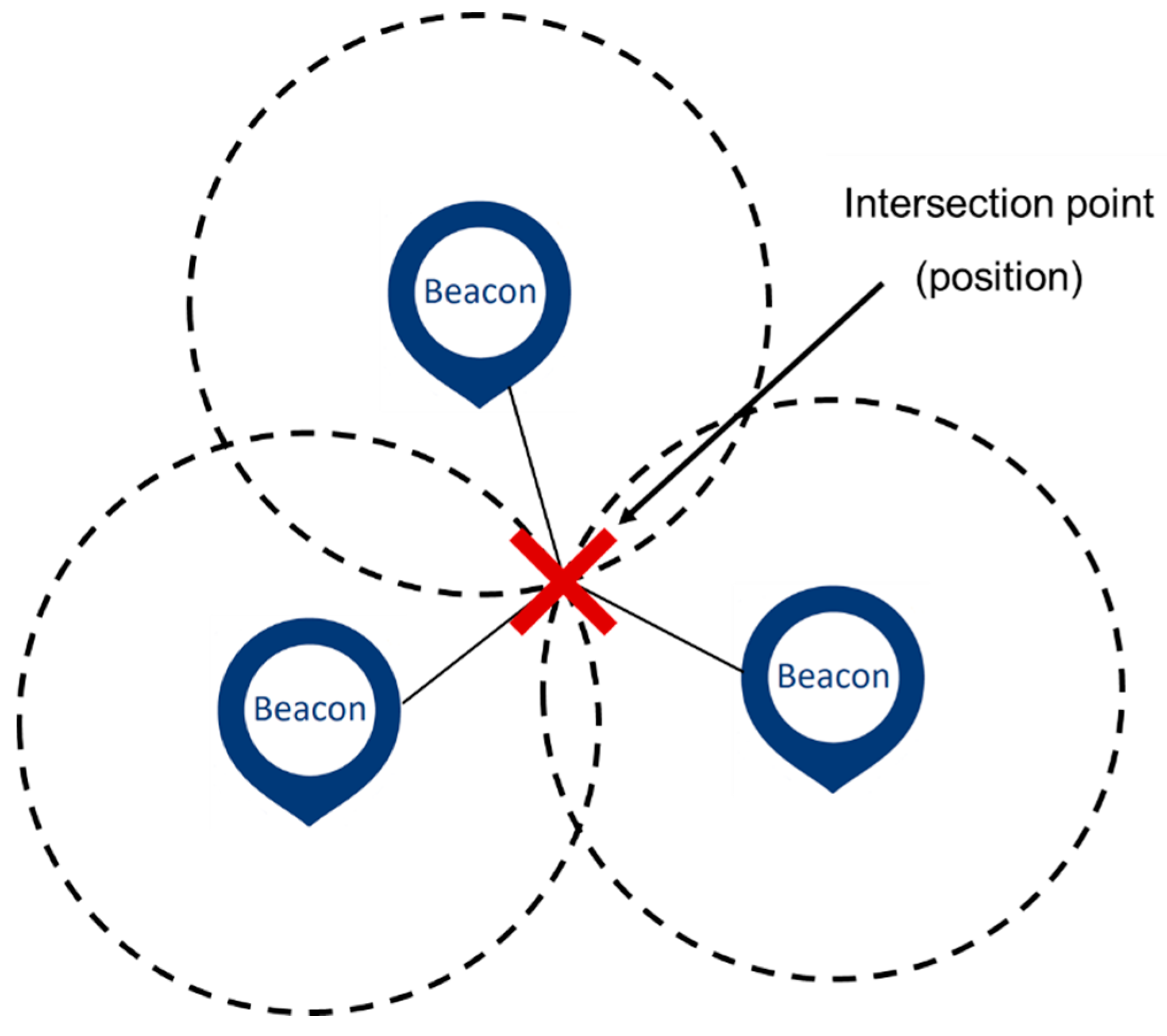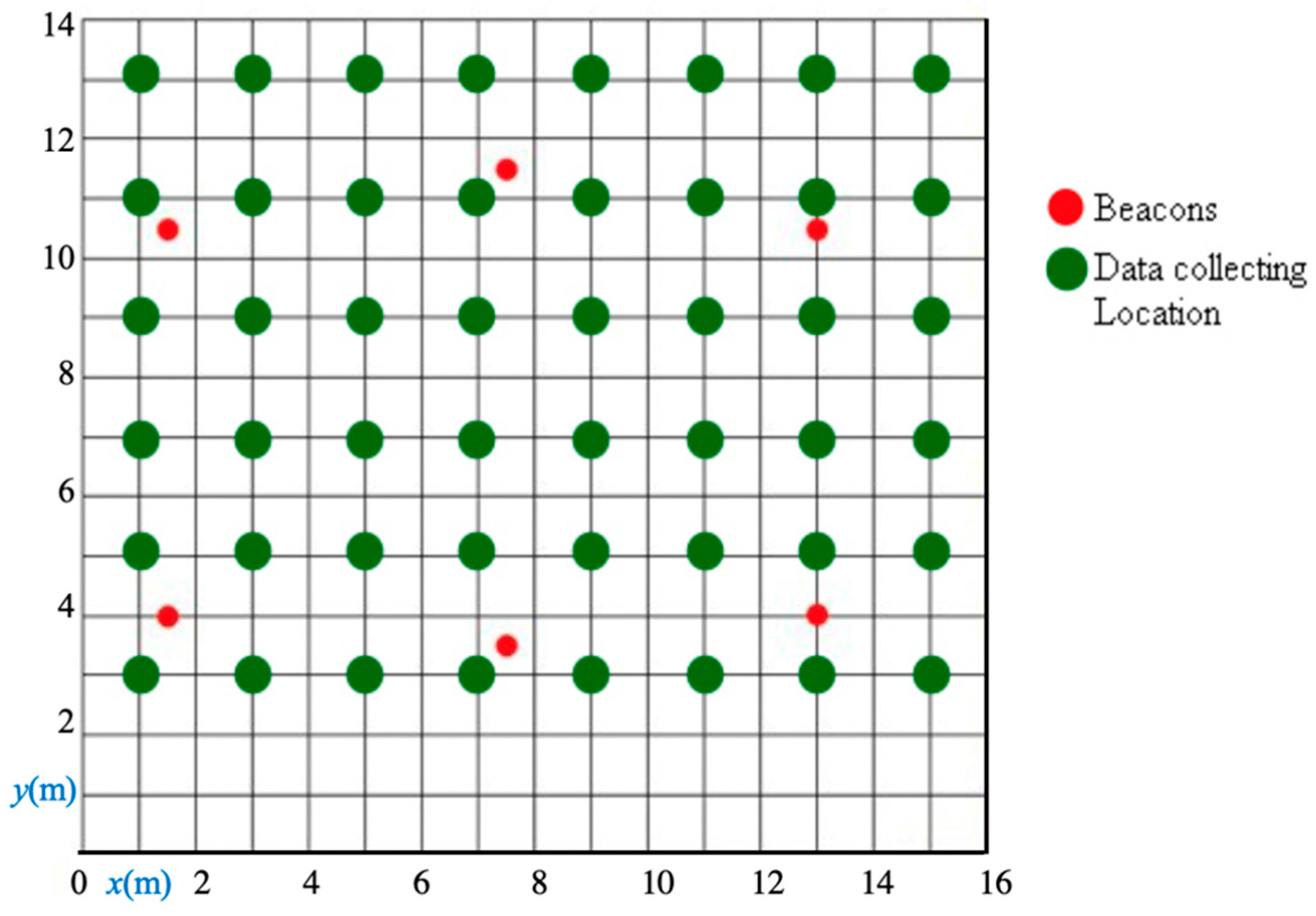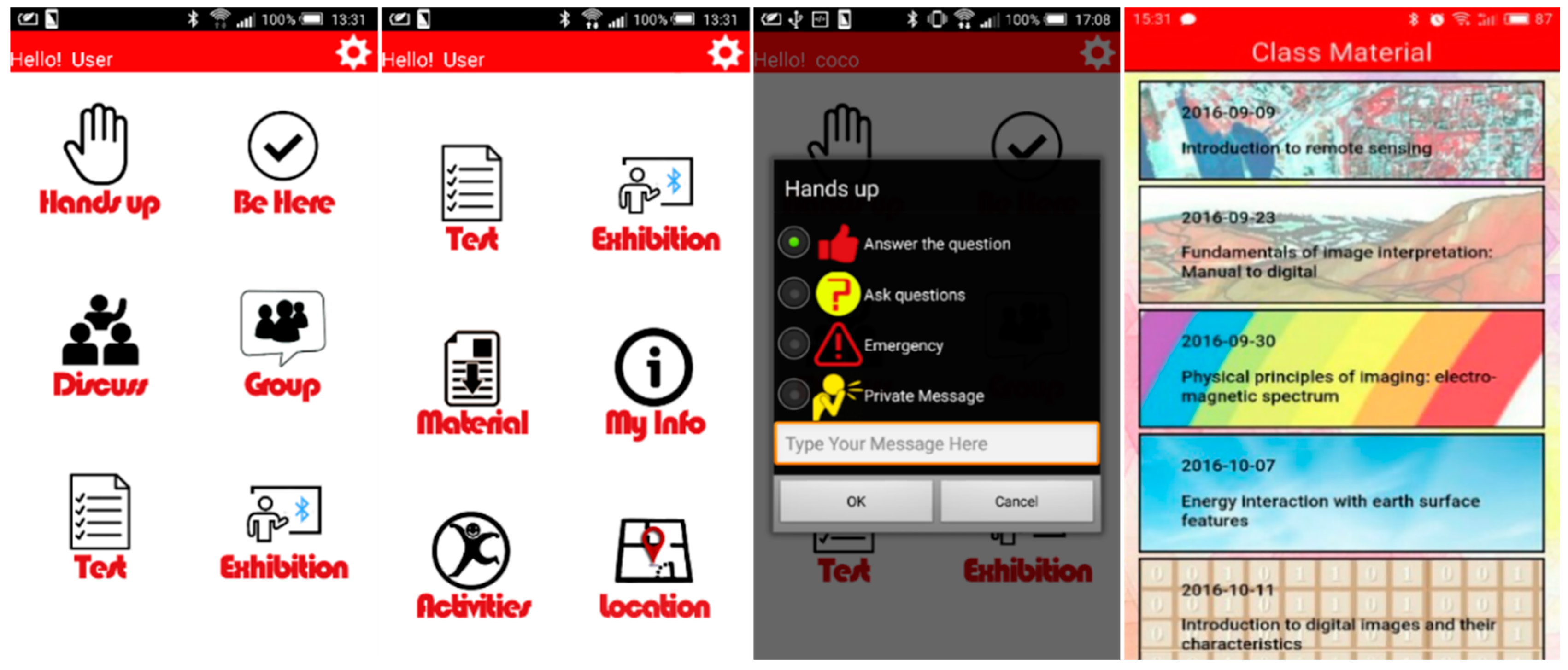Exploring Bluetooth Beacon Use Cases in Teaching and Learning: Increasing the Sustainability of Physical Learning Spaces
Abstract
1. Background
2. Methodology
3. Results
3.1. Overview
3.2. Attendance Monitoring
3.3. Smart Building and Smart Campus
3.4. Dissemination of Electronic Teaching Material and Information Via Beacons
3.5. Combining Augmented Reality Content with Beacon Technology
3.6. Positioning Methods
3.6.1. Proximity
3.6.2. Trilateration
3.6.3. Fingerprinting
4. Review of Pilot Work at the Hong Kong Polytechnic University (PolyU)
4.1. Overview of iClassPolyU
4.2. iClassPolyU Testing
5. Conclusion
Author Contributions
Funding
Acknowledgments
Conflicts of Interest
References
- Haythornthwaite, C.; Andrews, R. E-Learning Theory and Practice; SAGE Publications Ltd.: London, UK, 2011; Available online: http://sk.sagepub.com/books/e-learning-theory-and-practice (accessed on 15 February 2019).
- Weizenbaum, J. Computer Power and Human Reason: From Judgment to Calculation; W H Freeman & Co: Oxford, UK, 1976; p. 269. [Google Scholar]
- McKenna, B. The Predatory Pedagogy of “Distance Learning”: Face-to-Face Education in Peril. Anthropol. Now 2016, 8, 71–80. [Google Scholar] [CrossRef]
- Xu, D.; Jaggars, S.S. Online and Hybrid Course Enrollment and Performance in Washington State Community and Technical Colleges. CCRC Working Paper No. 31; Community College Research Center. Teachers College, Columbia University, 2011. Available online: https://files.eric.ed.gov/fulltext/ED517746.pdf (accessed on 15 February 2019).
- O’Hanlon, C. Resistance is Futile. T.H.E. J. 2009, 36, 32–36. [Google Scholar]
- Littlejohn, A. Reusing online Resources: A sustainable Approach to E-Learning; Kogan Page: London, UK, 2003. [Google Scholar]
- Littlejohn, A.; Falconer, I.; Mcgill, L. Characterising effective eLearning resources. Comput. Educ. 2008, 50, 757–771. [Google Scholar] [CrossRef]
- Schneckenberg, D. Overcoming barriers for eLearning in universities—portfolio models for eCompetence development of faculty. Br. J. Educ. Technol. 2010, 41, 979–991. [Google Scholar] [CrossRef]
- U.S. Department of Education, National Center for Education Statistics. Digest of Education Statistics, 2016. (NCES 2017-094), Table 311.15; 2018. Available online: https://nces.ed.gov/fastfacts/display.asp?id=80 (accessed on 15 February 2019).
- Bazzanella, L.; Roccasalva, G.; Valenti, S. Phygital Public Space Approach: A Case Study in Volpiano. Interact. Des. Archit. J. (IxD&A) 2014, 20, 23–32. [Google Scholar]
- Means, B.; Toyama, Y.; Murphy, R.; Bakia, M.; Jones, K. Evaluation of Evidence-Based Practices in Online Learning: A Meta-Analysis and Review of Online Learning Studies; U.S. Department of Education Office of Planning, Evaluation, and Policy Development Policy and Program Studies Service: Washington, DC, USA, 2009.
- Faragher, R.; Harle, R. An analysis of the accuracy of Bluetooth Low Energy for indoor positioning applications. J. Netw. Sci. Camb. Univ. 2014, 4, 22–26. [Google Scholar]
- De Blas, A.; López-de-Ipiña, D. Improving trilateration for indoors localization using BLE beacons. In Proceedings of the 2nd International Multidisciplinary Conference on Computer and Energy Science (SpliTech), Split, Croatia, 1–6 July 2017. [Google Scholar]
- Baek, S.H.; Seung, H.C. The trilateration-based BLE Beacon system for analysing user-identified space usage of New Ways of Working offices. Build. Environ. 2019, 149, 264–274. [Google Scholar] [CrossRef]
- Faragher, R.; Harle, R. Location Fingerprinting with Bluetooth Low Energy Beacons. IEEE J. Sel. Areas Commun. 2015, 33, 2418–2428. [Google Scholar] [CrossRef]
- Zafari, F.; Papapanagiotou, I.; Christidis, K. Microlocation for internet-of-things-equipped smart buildings. IEEE Internet Things J. 2015, 3, 96–112. [Google Scholar] [CrossRef]
- Jeon, K.E.; She, J.; Soonsawad, P.; Ng, P.C. Ble beacons for internet of things applications: Survey, challenges, and opportunities. IEEE Internet Things J. 2018, 5, 811–828. [Google Scholar] [CrossRef]
- Conte, G.; De Marchi, M.; Nacci, A.; Rana, V.; Sciuto, D. BlueSentinel: A first approach using iBeacon for an energy efficient occupancy detection system. In Proceedings of the BuildSys 2014—Proceedings of the 1st ACM Conference on Embedded Systems for Energy-Efficient Buildings, Memphis, TN, USA, 3–6 November 2014. [Google Scholar]
- Chen, L.; Chen, T.; Chen, D. iGuiding: A Mobile Campus Care and Guidance System Based on Internet of Things Technologies. In Proceedings of the 2018 IEEE International Conference on Pervasive Computing and Communications Workshops (PerCom Workshops), Athens, Greece, 19–23 March 2018; pp. 436–438. [Google Scholar]
- Bates, O.; Friday, A. Beyond Data in the Smart City: Repurposing Existing Campus IoT. IEEE Pervasive Comput. 2017, 16, 54–60. [Google Scholar] [CrossRef]
- Palma, L.C.; Pedrozo, E.A. Complex Matrix for the Analysis of Sustainable Transformative Learning: An Assessment Methodology of Sustainability Integration in Universities. Assess. Eval. High. Educ. 2015, 40, 817–832. [Google Scholar] [CrossRef]
- Nicol, D.; Draper, S. A Blueprint for Transformational Organisational Change in Higher Education: REAP as a Case Study: Higher Education Academy. 2009. Available online: http://www.psy.gla.ac.uk~steve/rap/NicolDraperTransf4.pdf (accessed on 15 February 2019).
- Lee, J.H.; Shvetsova, O.A. The Impact of VR Application on Student’s Competency Development: A Comparative Study of Regular and VR Engineering Classes with Similar Competency Scopes. Sustainability 2019, 11, 2221. [Google Scholar] [CrossRef]
- Sorbi, S.A. Educational research in developing 3D spatial skills for engineering students. Int. J. Sci. Educ. 2009, 31, 459–480. [Google Scholar] [CrossRef]
- Fee, S.B.; Holland-Minkley, A.M.; Lombardi, T.E. New Directions for Computing Education Embedding Computing across Disciplines; Springer: Berlin, Germany, 2017. [Google Scholar]
- Chou, P.N.; Chen, W.F.; Wu, C.Y.; Carey, R.P. Utilizing 3D open source software to facilitate student learning of fundamental engineering knowledge: A quasi-experimental study. Int. J. Eng. Educ. 2017, 33, 382–388. [Google Scholar]
- Stepanyan, K.; Littlejohn, A.; Margaryan, A. Sustainable e-Learning: Toward a Coherent Body of Knowledge. Educ. Technol. Soc. 2013, 16, 91–102. [Google Scholar]
- Sheen, K.A.; Wong, M.S.; Kam, R.; Kwok, C.Y.T.; Lu, K. Gauging the Student Learning Experience of a Mobile Application Using iBeacon Technology. In Advances in Intelligent Systems and Computing; Goonetilleke, R., Karwowski, W., Eds.; Springer: Cham, Switzerland, 2018; Volume 789. [Google Scholar]
- Heo, J.; Chung, K.; Yoon, S.; Yun, S.B.; Ma, J.W.; Ju, S. Spatial-data-driven student characterization in higher education. In Proceedings of the PredictGIS’17, Redondo Beach, CA, USA, 7–10 November 2017. [Google Scholar]
- Heo, J.; Yoon, S.; Oh, W.S.; Ma, J.W.; Ju, S.; Yun, S.B. Spatial computing goes to education and beyond: Can semantic trajectory categorize students? In Proceedings of the 5th ACM SIGSPATIAL International Workshop on Analytics for Big Geospatial Data, BigSpatial 2016, Burlingame, CA, USA, 31 October 2016; pp. 14–17. [Google Scholar]
- Ex Libris. App Tour: Take a Tour of campusM Functionality. 2018. Available online: https://www.exlibrisgroup.com/products/campusm-mobile-campus-app-platform/campusm-app-tour/ (accessed on 15 February 2019).
- TeacherKit. Reasons to Love TeacherKit. 2017. Available online: http://teacherkit.net/ (accessed on 15 February 2019).
- Noguchi, S.; Niibori, M.; Zhou, E.; Kamada, M. Student attendance management system with bluetooth low energy beacon and android devices. In Proceedings of the 18th International Conference on Network-Based Information Systems (NBiS), Taipei, Taiwan, 2–4 September 2015; IEEE: New York, NY, USA, 2015; pp. 710–713. [Google Scholar]
- Deugo, D. Using Beacons for Attendance Tracking. In Proceedings of the FECS’16—the 12th International Conference on Frontiers in Education: Computer Science and Computer Engineering, Las Vegas, NV, USA, 25–28 July 2016. [Google Scholar]
- Redetzke, S.; Vanner, A.; Otieno, R. Smart Room Attendance Monitoring and Location Tracking with iBeacon Technology. Worcester Polytechnic Institute, Electrical and Computer Engineering Department as a Major Qualifying Project (MQP), 2017. Available online: https://web.wpi.edu/Pubs/E-project/Available/E-project-042517-170052/unrestricted/COMPLETE_eCDR_MQP_SUBMISSION.pdf (accessed on 15 February 2019).
- Mustafa, J.H.; Attendance Monitoring Using Beacon. Final Year Project for BSc Hons Computer Science. University of Greenwich, 2016. Available online: http://attendimote.co.uk/attendimote.pdf (accessed on 15 February 2019).
- Bae, M.Y.; Cho, D.J. Design and implementation of automatic attendance check system using BLE beacon. Int. J. Multimedia Ubiquitous Eng. 2015, 10, 177–186. [Google Scholar] [CrossRef]
- Lau, H.K.; Mok, Y.Q.; Daut, N.; Tahir, A.; Chung, S.K.; Chua, B.L. Beacon-integrated attendance app. Adv. Sci. Lett. 2018, 24, 1114–1118. [Google Scholar] [CrossRef]
- Lucas, B.; Ma, L.; Chen, D. iBeaconing: A low-cost, wireless student protection system. In Proceedings of the 11th International Conference on Wireless Algorithms, Systems, and Applications, Bozeman, MT, USA, 8–10 August 2016. [Google Scholar]
- Gibbons, C. iBeacons for Recruitment Events. 2015. Available online: http://blogs.brad.ac.uk/web-team/2015/04/20/ibeacons-for-recruitment-events/ (accessed on 15 February 2019).
- Merode, D.; Tabunshchyk, G.; Patrakhalko, K.; Yuriy, G. Smart Campus based on iBeacon Technology. In Proceedings of the 14th International Symposium on Ambient Intelligence and Embedded Systems, Oostende, Belgium, 24–26 September 2015. [Google Scholar]
- Husni, E. Mobile Application for Smart Campus System with iBeacon–uBeacon. Adv. Sci. Lett. 2017, 23, 3746–3750. [Google Scholar] [CrossRef]
- Smallwood, L. Beacons at Clevedon School. 2015. Available online: http://lewissmallwood.co.uk/beacons-at-clevedon-school/ (accessed on 15 February 2019).
- Budina, J.; Klapka, O.; Zmitko, M. Mobile context-oriented platform for learning support. In Proceedings of the 2015 13th International Conference on Emerging eLearning Technologies and Applications (ICETA), Stary Smokovec, Slovakia, 26–27 November 2015. [Google Scholar]
- Bhattacharya, D.; Canul, M.; Knight, S. Case Study: Impact of the Physical Web and BLE Beacons. In Proceedings of the 50th Hawaii International Conference on System Sciences, Waikoloa, HI, USA, 4–7 January 2017. [Google Scholar]
- Casado-Mansilla, D.; Foster, D.; Lawson, S.; Garaizar, P.; López-de-Ipiña, D. ‘Close the Loop’: An iBeacon App to Foster Recycling Through Just-in-Time Feedback. In Proceedings of the 33rd Annual ACM Conference Extended Abstracts on Human Factors in Computing Systems, Seoul, Korea, 18–23 April 2015; pp. 1495–1500. [Google Scholar]
- Bradley, J.; Henshaw, N.; McVoy, L.; French, A.; Gilbertson, K.; Becksford, L.; Givens, E. Creation of a Library Tour Application for Mobile Equipment using iBeacon Technology. Code4Lib J. 2016, 32, 1–17. [Google Scholar]
- Willshaw, G. Opening Doors with Bluetooth Beacons. 2015. Available online: http://libraryblogs.is.ed.ac.uk/librarylabs/2015/11/12/opening-doors-with-bluetooth-beacons/ (accessed on 15 February 2019).
- Wu, S.K.; Bess, M.; Price, B.R. Digitizing library outreach: Leveraging Bluetooth beacons and mobile applications to expand library outreach in digitizing the modern library and the transition from print to electronic. In Digitizing the Modern Library and the Transition from Print to Electronic; Bhardwaj, R.K., Ed.; IGI Global: Hershey, PA, USA, 2018; pp. 193–203. [Google Scholar]
- McDonald, K.; Glover, I. Exploring the transformative potential of Bluetooth beacons in higher education. Res. Learn. Technol. 2016, 24, 32166. [Google Scholar] [CrossRef]
- de la Guia, E.; Camacho, V.L.; Orozco-Barbosa, L.; Lujan, V.M.B.; Penichet, V.M.R.; Perez, M.L. Introducing IoT and Wearable Technologies into Task-Based Language Learning for Young Children. IEEE Trans. Learn. Technol. 2016, 9, 366–378. [Google Scholar] [CrossRef]
- Wu, Y.-W.; Young, L.-M.; Wen, M.-H. Developing an iBeacon-based Ubiquitous Learning Environment in Smart Green Building Courses. Int. J. Eng. Educ. 2016, 32, 782–789. [Google Scholar]
- Tsai, H.-H.; Hou, X.-Y.; Yong, Y.-M.; Chiou, K.-C.; Yu, P.-T. Develop the Interactive Feedback Portfolio System with iBeacon Technology Applied in Flipped Classroom Learning Activities. In Proceedings of the 11th International Conference, ICBL 2018, Osaka, Japan, 31 July–2 August 2018. [Google Scholar]
- Kim, I.-M. Design and development a smart-phone application for class interactions. J. Dig. Contents Soc. 2014, 15, 721–727. [Google Scholar] [CrossRef]
- Zimmerman, H.T.; Land, S.M.; Maggiore, C.; Ashley, R.W.; Millet, C. Designing outdoor learning spaces with beacons: Combining place-based learning with the internet of things. In Transforming Learning, Empowering Learners: The International Conference of the Learning Sciences (ICLS) 2016, Volume 2; Looi, C.K., Polman, J.L., Cress, U., Reimann, P., Eds.; International Society of the Learning Sciences: Singapore, 2016. [Google Scholar]
- Chen, G.; Xin, Y.; Chen, N.S. Informal learning in science museum: Development and evaluation of a mobile exhibit label system with iBeacon technology. Educ. Tech Res. Dev. 2017, 65, 719–741. [Google Scholar] [CrossRef]
- Chen, G.; Zhang, Y.; Chen, N.S.; Fan, Z. Context-Aware Ubiquitous Learning in Science Museum with iBeacon Technology. In Learning, Design, and Technology; Spector, M., Lockee, B., Childress, M., Eds.; Springer: Cham, Switzerland, 2016. [Google Scholar]
- Chang, WT. Proactive guiding with iBeacon in art museum. In Proceedings of the 2017 Pacific Neighborhood Consortium Annual Conference and Joint Meetings (PNC), National Cheng Kung University, Tainan, Taiwan, 7–9 November 2017. [Google Scholar]
- Jeng, Y.; Hong, M.; Lu, H. The Development of the Mobile Situated Learning Application Based on Microlocation Technology. In Proceedings of the 2017 6th IIAI International Congress on Advanced Applied Informatics (IIAI-AAI), Hamamatsu, Japan, 9–13 July 2017; pp. 715–718. [Google Scholar]
- Bjork, R.A. Environmental context and human memory. Memory Cognit. 1978, 6, 342–353. [Google Scholar]
- Chan, R.Y.-Y.; Bai, X.; Chen, X.; Jia, S.; Xu, X.-h. iBeacon and HCI in Special Education: Micro-Location Based Augmentative and Alternative Communication for Children with Intellectual Disabilities. In Proceedings of the 2016 CHI Conference Extended Abstracts on Human Factors in Computing Systems, San Jose, CA, USA, 7–12 May 2016; pp. 1533–1539. [Google Scholar]
- Locly. Welcome to Locly. 2018. Available online: https://locly.com/ (accessed on 15 February 2019).
- Locly. Locly Client Gallery. 2018. Available online: https://locly.com/gallery/ (accessed on 15 February 2019).
- Jurkovičova, L.; Ĉervenka, P.; Hrivíková, T. E-learning in augmented reality utilizing iBeacon technology. In Proceedings of the 10th International Conference on e-Learning—ICEL 2015, Nassau, The Bahamas, 25–26 June 2015. [Google Scholar]
- Karlsson, E.; Nygren, O.; Gamboa, M.; Thander, F. ArQuest: Augmented reality in education. In Proceedings of the SIDeR 2016, Malmö, Sweden, 2 April 2016. [Google Scholar]
- Larsson, J. Distance Estimation and Positioning Based on Bluetooth Low Energy Technology. Master’s Thesis, KTH Royal Institute of Technology, Stockholm, Sweden, 2015. Available online: http://www.diva-portal.org/smash/get/diva2:859549/FULLTEXT01.pdf (accessed on 15 February 2019).
- Cantón Paterna, V.; Calveras Augé, A.; Paradells Aspas, J.; Pérez Bullones, M.A. A Bluetooth Low Energy Indoor Positioning System with Channel Diversity, Weighted Trilateration and Kalman Filtering. Sensors 2017, 17, 2927. [Google Scholar] [CrossRef]
- Wang, Q.; Guo, Y.; Yang, L.; Tian, M. An Indoor Positioning System Based on iBeacon. In Transactions on Edutainment XIII. Lecture Notes in Computer Science; Pan, Z., Cheok, A., Müller, W., Zhang, M., Eds.; Springer: Berlin/Heidelberg, Germany, 2017; Volume 10092. [Google Scholar]
- Zhang, H.; Duan, Q.; Duan, P.; Hu, B. Integrated iBeacon/PDR Indoor Positioning System Using Extended Kalman Filter in Advances in Materials, Machinery, Electrical Engineering (AMMEE 2017). Adv. Eng. Res. 2017, 114, 9–16. [Google Scholar]
- Rida, M.E.; Liu, F.; Jadi, Y.; Algawhari, A.A.; Askourih, A. Indoor Location Position Based on Bluetooth Signal Strength. In Proceedings of the 2015 2nd International Conference on Information Science and Control Engineering, Shanghai, China, 24–26 April 2015. [Google Scholar]
- Wei, T.; Bell, S. Indoor Localization Method Comparison: Fingerprinting and Trilateration Algorithm. 2011. Available online: http://rose.geog.mcgill.ca/ski/system/files/fm/2011/Wei.pdf (accessed on 15 February 2019).
- Venkatesh, V.; Davis, F.D. A Theoretical Extension of the Technology Acceptance Model: Four Longitudinal Field Studies. Manag. Sci. 2000, 2, 186–204. [Google Scholar] [CrossRef]
- Delianidi, M.; Papanikolaou, A.; Ilioudis, C. A Mobile Augmented Reality (mAR) Blended Learning Application for Primary School Pupils. In Proceedings of the Blended Learning for 21st Century Learner—1st International Association for Blended Learning Conference (IABL 2016), Kavala, Greece, 22–24 April 2016. [Google Scholar]
- Heo, J.; Lim, H.; Yun, S.B.; Ju, S.; Park, S.; Lee, R. Descriptive and Predictive Modeling of Student Achievement, Satisfaction, and Mental Health for Data-Driven Smart Connected Campus Life Service. In Proceedings of the 9th International Conference on Learning Analytics & Knowledge, Tempe, AZ, USA, 4–8 March 2019; pp. 531–538. [Google Scholar]
- Tabunshchyk, G.; Van Merode, D. Intellectual Flexible Platform for Smart Beacons. In Online Engineering & Internet of Things; Lecture Notes in Networks and Systems, 22; Auer, M., Zutin, D., Eds.; Springer: Cham, Switzerland, 2018. [Google Scholar]
- Kim, J.; Cheong, S.-K. Research on an Authentication Algorithm for an Electronic Attendance System in the Constructing of a Smart Campus. Int. J. Secur. Its Appl. 2013, 7, 199–208. [Google Scholar] [CrossRef]




© 2019 by the authors. Licensee MDPI, Basel, Switzerland. This article is an open access article distributed under the terms and conditions of the Creative Commons Attribution (CC BY) license (http://creativecommons.org/licenses/by/4.0/).
Share and Cite
Griffiths, S.; Wong, M.S.; Kwok, C.Y.T.; Kam, R.; Lam, S.C.; Yang, L.; Yip, T.L.; Heo, J.; Chan, B.S.B.; Xiong, G.; et al. Exploring Bluetooth Beacon Use Cases in Teaching and Learning: Increasing the Sustainability of Physical Learning Spaces. Sustainability 2019, 11, 4005. https://doi.org/10.3390/su11154005
Griffiths S, Wong MS, Kwok CYT, Kam R, Lam SC, Yang L, Yip TL, Heo J, Chan BSB, Xiong G, et al. Exploring Bluetooth Beacon Use Cases in Teaching and Learning: Increasing the Sustainability of Physical Learning Spaces. Sustainability. 2019; 11(15):4005. https://doi.org/10.3390/su11154005
Chicago/Turabian StyleGriffiths, Sion, Man Sing Wong, Coco Yin Tung Kwok, Roy Kam, Simon Ching Lam, Lin Yang, Tsz Leung Yip, Joon Heo, Benedict Shing Bun Chan, Guanjing Xiong, and et al. 2019. "Exploring Bluetooth Beacon Use Cases in Teaching and Learning: Increasing the Sustainability of Physical Learning Spaces" Sustainability 11, no. 15: 4005. https://doi.org/10.3390/su11154005
APA StyleGriffiths, S., Wong, M. S., Kwok, C. Y. T., Kam, R., Lam, S. C., Yang, L., Yip, T. L., Heo, J., Chan, B. S. B., Xiong, G., & Lu, K. (2019). Exploring Bluetooth Beacon Use Cases in Teaching and Learning: Increasing the Sustainability of Physical Learning Spaces. Sustainability, 11(15), 4005. https://doi.org/10.3390/su11154005







